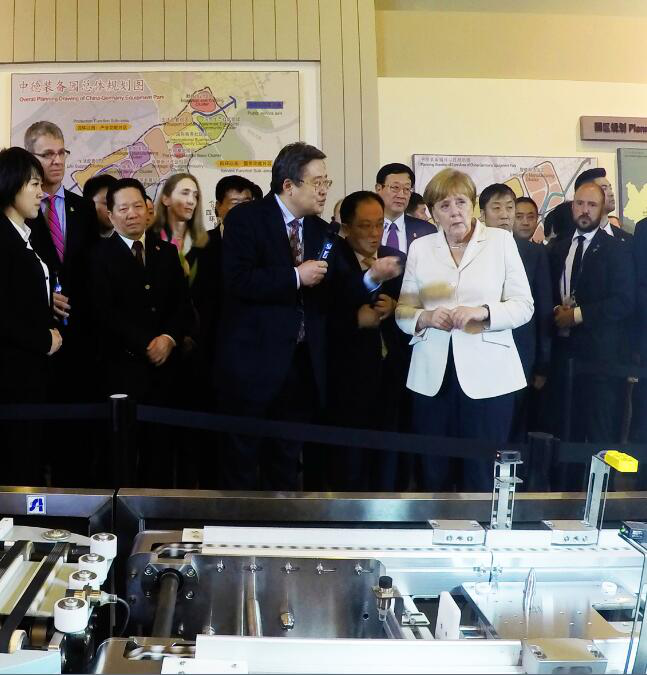- About Us
- News
- Results Released
- Application Scenarios
- Resource Center
- Meeting

Adaptive modular manufacturing verification platform for customization
Shenyang Institute of Automation (SIA), Chinese Academy of Sciences
China Academy of Information and Communications Technology
Sunny Intelligent Technology Co., Ltd.
China's manufacturing industry is in a crucial period of transformation and upgrading, becoming less rigid and large-scale and more personalized.
Discrete manufacturing industries feature customization and fast product upgrade. The adaptive modular manufacturing verification platform leverages the software-defined reconfigurable modular intelligent manufacturing technology system to automatically adjust the tasks, technological processes, path planning, and control parameters in the manufacturing and assembly processes, optimizing the assembly process and robot tasks. In addition, the platform uses modular and highly flexible control networks to implement adaptive recombination of the modular mechanical structure and build modular, interconnected, and intelligent production systems. This greatly shortens the product delivery period, provides a quick response to the large-scale production requirements of highly customized products, and implements large-scale and economical production of a small batch of or even a single customized product. These benefits cannot be offered by traditional production systems that are rigid and large-scale.
The platform constructs a software-defined adaptive reconfigurable intelligent management and control system on the device side to collect, analyze, and compute information about devices and production process. This optimizes the techniques and scheduling of device tasks, greatly improving the computing efficiency, as well as device and system response speed. For the assembly of parts in customization, to implement the adaptive recombination of the technological process, task scheduling, and production structure, the platform uses the following technologies:
●System structure planning, module interface standardization, and precise locating and mobile interconnection of function modules: implementing modular and reconfigurable mechanical structure of production systems and supporting module-based production
●Industrial SDN: implementing adaptive allocation of communication resources and supporting wireless and reconfigurable industrial networks
●Semantic digital factory modeling and dynamic service combination: automatically combining the procedure, step, and device model
The platform is used to test and verify technologies related to software-defined reconfigurable intelligent manufacturing, including:
●Interconnection technologies for industrial devices and device-level security protection
●Technologies for planning modular reconfigurable unit system structures and building mechanical structures
●Technologies for building adaptive wireless and reconfigurable industrial networks
●Industrial SDN–based control network full interconnection and network security technologies
●Semantic digital factory modeling technology
●Technologies and products related to adaptive dynamic service combination based on technological processes
●Intelligent scheduling of multiple tasks with different priorities, and artificial intelligence (AI) algorithms
Figure 4-1 shows the structure of the adaptive modular manufacturing verification platform for customization.
This platform consists of:
●Cloud platform
●Application domain: design and development platform, ERP, and MES
●Data domain: intelligent management and control system
●Network domain: WIA-FA based industrial wireless adaptive full-mesh network system
●Device domain: modular reconfigurable unit, flexible intelligent logistics system, sensor, and others
The design and development platform, intelligent management and control system, modular reconfigurable unit, and service platform constitute an end-to-end digital integration system that includes design, manufacturing, and services and achieve vertical integration of sales, enterprise management, production management, and the device layer. They are used to verify full-lifecycle management and end-to-end integration technologies of intelligent manufacturing systems.
The intelligent management and control system, WIA-FA based industrial wireless adaptive full interconnection network system, modular reconfigurable unit, and flexible intelligent logistics system constitute a network production system, which is used to verify the vertical integration technologies of the intelligent manufacturing system.
Figure 4-1 Adaptive modular manufacturing verification platform for customization

As shown in Figure 4-1, the platform consists of the following levels:
●Device level: robots, sensors, flexible transmission units, and processing unit modules
●Network level: WIA-FA based industrial IoT system and products such as industrial SDN–based management and control interconnection wireless gateways
●Data level: semantic digital factory model library, dynamic service combination engine, production technique and task adaptive dynamic adjustment module, and data analysis and processing module for predictive maintenance
●Application level: ERP and MES for personalized product customization
●Cloud application level: e-commerce platform for personalized product customization and cloud platform for device predictive maintenance
Based on the SIA-developed industrial IoT technology system (comprised of WIA-FA and wireless products such as SDN wireless gateways) and software-defined management and control technologies, the platform streamlines interfaces between control systems and management software such as e-commerce, ERP, and MES, and implements vertical seamless integration of network production systems, enabling quick manufacturing of personalized products. The self-developed software-defined reconfigurable wireless control network system enables the modular structure and dynamic reassembly of the control system based on requirements. The digital factory modeling technology constructs an industrial control semantic ontology library. This library is a virtual manufacturing system of information space that has a one-to-one mapping relationship with actual physical systems. The virtual manufacturing system and the intelligent management and control system quickly reassemble the production system in a software-defined manner. This enables the production system to dynamically respond to changes in design and production requirements, providing more flexibility than traditional production systems.
The platform is characterized by its intelligent factory advantages, including customization, adaptive production line recombination, and predictive maintenance of production devices. Predictive maintenance greatly shortens the device downtime and significantly increases the time in which the device in use. The supporting technology system and products of the platform will facilitate the exploration of technology systems and solutions suitable for intelligent manufacturing in China and promote the digital transformation of enterprises.
The platform is applicable to industries including the following:
●Household appliance manufacturing industry
Currently, many household appliance manufacturing enterprises are seeking to transition from large-scale manufacturing to large-scale customization. In contrast to traditional factory-centric production, enterprises directly respond to user requirements and manufacture household appliances accordingly, implementing precise, efficient, and large-scale flexible manufacturing that is user-driven. This would resolve the following problems:
-Inflexible production, high customization costs, and low efficiency of original production lines: The platform supports modes such as smart production scheduling, smart production, smart logistics, and virtual-physical integration, quickly responding to user requirements.
-Failure of the existing PLC-centered control system in editing and processing complex logic: The interconnected management and control system developed by SIA quickly reuses management and control processes and logic of the original production lines, virtualizing and modularizing production devices, and meeting the rapidly growing requirements of consumers for personalized services.
-Slow response and product upgrade of traditional manufacturing: The interconnected management and control system developed by SIA shortens the OTD from 21 days to 7 days, implements the full-process openness, transparency, and visibility for factories, and transforms users into designers and participants.
●Rail transport manufacturing industry
The rail transport manufacturing industry is seeking to transition from extensive processing and assembly, as well as passive device maintenance, towards intelligent optimized scheduling management and proactive predictive device maintenance. The industry also aims to shift from human-centered production management and device maintenance to data-driven, quantitative, precise, and intelligent management and maintenance. This would resolve the following problems:
-Low yield caused by human-centered production device management, low device efficiency, low production efficiency, and delayed device maintenance: Machine tools, robots, and AGVs are interconnected, visualizing the device status and production process and implementing intelligent running and maintenance of the production system.
-Difficulty in interconnecting heterogeneous interfaces and experience-based device fault diagnosis, production scheduling, and scheduling: The platform increases the device utilization from 45% to 70%, makes the production process transparent and visible, and makes production devices and systems more intelligent.
●Photoelectric camera module industry
Currently, the photoelectric camera module industry does not collect and monitor product information throughout the entire production process, and does not analyze phases or factors of quality and energy bottlenecks, or other information such as the production process, devices, and energy. The platform tackles technical challenges of the reference model for the digital factory of intelligent manufacturing, full-process data collection and analysis, and full-process-data-driven product design and technological process optimization, as well as running management and control. This improves the yield and production efficiency, and reduces power consumption, reflecting the advantages of customization and manufacturing in small, numerous batches. The platform improves the intelligence of equipment sets in China's photoelectric camera module industry, satisfying the rapidly growing requirements for photoelectric camera modules in industries such as drones, wearable devices, mobile phones, and automobiles.
Based on the adaptive modular intelligent manufacturing technology system for customization, the platform can simulate the following scenarios:
Customers can flexibly select product configurations on the e-commerce platform to generate a personalized product order. The order is generated in the ERP and distributed to the MES for production scheduling. The order and scheduling information is distributed to the control system through the PCO interface. Through the intelligent management and control system, each production unit can communicate with products and materials. This enables the intelligent factory to quickly complete the production tasks of personalized products, such as assembling personalized parts for the order or completing personalized processing tasks.
●Semantic modeling
The platform sets up an intelligent management and control system in the data domain, constructs a digital factory model library by leveraging the semantic technology, and streamlines device interoperability interfaces, implementing unified management of cross-vendor interoperability and semantics. The semantic digital factory modeling and dynamic service combination technologies solve the problem of decoupling of device model description, technological process, and task scheduling. The technologies also overcome difficulties regarding correctness and executability of technological process and task recombination, model and rule query, and real-time association.
The semantic technology is used to establish a model library, and the model's attributes with the smallest unit, the shortest process, and individual steps are defined as atomic actions to decouple the model from the process. The correctness and executability of the system structure model and technological process combination are ensured using the structure, function, capability constraint, and technique knowledge rules. The space-time correlation retrieval technology improves the real-time performance of atomic action query, association, and combination.
●Intelligent scheduling
The platform allows users to place personalized orders based on their preferences, and intelligently and preferentially processes these orders. The platform has two robots for assembly, which can concurrently assemble products of three orders. The two robots are equipped with device-based security protection capabilities to prevent collisions and injuries to people. The platform's two robots can also load and unload materials. For common orders, multiple assembly schemes can be configured for the two robots, including the scheme for achieving the highest assembly efficiency, the scheme for sequential processing, and the scheme for preferentially assembling the simplest product. When an urgent order is received, with security guaranteed (collisions and injuries are eliminated), the intelligent management and control system automatically switches to the scheme for preferentially processing urgent orders. The intelligent management and control system can seamlessly and preferentially process orders without manual intervention, shortening the product manufacturing period.
●Dynamic service combination engine
The dynamic service combination engine encapsulates production techniques and tasks into services. This streamlines interoperability interfaces of different protocols, software, and systems, integrating information between systems. In addition, production techniques and tasks can be dynamically reassembled based on the product design and production requirement changes. In this way, the production system can be quickly recombined in a software-defined manner, making the production mode far more flexible and greatly improving the adaptability and flexibility of the production system to meet different requirements for product design and production.
●Data edge processing
A large amount of sensor, robot, and PLC data is collected from devices. The data is collected frequently and is in different formats. If a huge volume of data is directly uploaded to the cloud platform without edge processing on the device side, network congestion occurs, wasting network resources and even affecting important data that has higher requirements on real-time transmission and accuracy. Therefore, edge computing needs to be performed in the data domain to perform basic processing on the data used for predictive maintenance, including filtering, denoising, fitting, dimension reduction, and feature extraction. In addition, only one data format is used, and data is classified into different levels of importance. Important data is preferentially uploaded to the cloud platform, improving network resource usage and preventing data from being stacked.
The predictive maintenance system deployed on the cloud manufacturing service platform collects the data for which basic processing has been performed in the data domain and uses the industrial wireless IoT to carry out real-time detection, monitoring, and analysis of the health status information such as the temperature and vibration of production devices. This helps to determine information such as the health status, fault type, fault location, and remaining lifecycle of devices.
Predictive maintenance reduces the maintenance workload and labor intensity, improves the device reliability, prolongs the device lifecycle, improves the device utilization, and reduces maintenance costs. This improves the enterprises' overall competitiveness.
After being applied to discrete manufacturing industries, the preceding platform and solutions are expected to greatly improve production efficiency and device utilization. During the Industry 4.0 era, they will enable production and manufacturing enterprises to easily meet the requirements for large-scale and economical production of highly customized products. This improves the competitiveness of enterprises, generates more than CNY 1 billion in revenue, and paves the way for further exploration of technology systems and solutions suitable for intelligent manufacturing in China, promoting the digital transformation of enterprises.
The core technology system and products of the adaptive modular manufacturing verification platform for customization greatly improve the intelligence of production devices and processes, and streamline the vertical integration of the network production system from the e-commerce platform to the management and control system. This greatly improves the efficiency of the management and control system and the utilization of production devices. The intelligent management and control system developed by SIA can dynamically and adaptively adjust the structure, production process sequence, and robot action combination of the production system, improving the flexibility of the production system software and hardware and increasing the efficiency and intelligence of the manufacturing process.
Edge computing brings the following benefits to the manufacturing industry:
●Flexible device replacement: Reduces manpower by 50% and doubles the replacement efficiency.
●Flexible production plan adjustment: Minimizes the time taken for adjusting the production process upon production switching in the mixed-line assembly process and material path changing.
●Rapid deployment of new techniques and models: Reduces the time required for new technique deployment and configuration by more than 80%.
With the gradual transition from the large-scale, batch consumption stage to the personalized consumption stage, consumers attach increasing importance to the individualized characteristics and taste of products. Traditional production systems are rigid and therefore cannot meet these requirements. Large-scale and economical production of highly customized products will be the major trend of discrete manufacturing industries in the future.
The platform leverages the software-defined reconfigurable modular intelligent manufacturing technology system and is applied in the household appliance manufacturing industry. The platform supports smart production scheduling, smart production, smart logistics, and virtual-physical integration modes, quickly responding to user requirements and resolving problems of inflexible production, high customization costs, and low efficiency of original production lines. The interconnected management and control system developed by SIA quickly reuses management and control processes and logic of the original production lines, virtualizing and modularizing production devices, meeting rapidly growing personalized requirements of consumers, and resolving the failure of the existing PLC-centered control system in editing and processing complex logic. In addition, the interconnected management and control system shortens the OTD from 21 days to 7 days, implements the full-process openness, transparency, and visibility for factories, and transforms users into designers and participants, resolving problems of long response period and slow product upgrade of traditional manufacturing.
For the photoelectric camera module industry, in traditional PLC+OPC mode, if the number of order types increases and the number of products that need to be manufactured in a single batch is small, the control logic and steps need to be reset, and interfaces need to be reconfigured. This takes a long time and lengthens the time to market (TTM). The platform can be applied to the photoelectric camera module industry to shorten the TTM of new products. The platform leverages the software-defined reconfigurable modular intelligent manufacturing technology system to automatically adjust the tasks, technological processes, path planning, and control parameters in the manufacturing and assembly processes, optimizing the assembly process and robot tasks. In addition, the platform uses modular and highly flexible control networks to implement adaptive recombination of the modular mechanical structure and build modular, interconnected, and intelligent production systems. This reduces the operation costs by 50%, product production cycle by 50%, and defective product rate by 50%. The platform enhances the flexible interaction between ICT systems and OT systems in the manufacturing industry, promoting intelligent manufacturing.
In recent years, the platform has received wide attention throughout China and from all sectors. On March 16, 2015, the subsystem for predictive maintenance of robot speed reducers was exhibited at CeBIT 2015, Hannover, Germany. Chinese Vice Premier of the State Council Ma Kai, German Vice Chancellor Sigmar Gabriel, and Chinese Minister of Industry and Information Technology Miao Wei viewed the product demonstration.
Figure 9-1 Chinese Vice Premier of the State Council and German Vice Chancellor visit the exhibition booth of the platform subsystem at CeBIT 2015
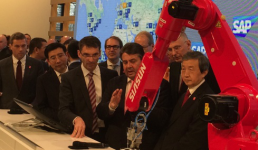
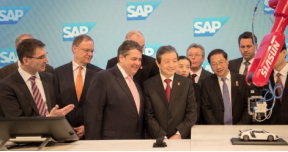
On December 16, 2015, at the second World Internet Conference (WIC), Xi Jinping, the President of the People's Republic of China, and Liu Yunshan, a member of the Standing Committee of the Political Bureau of the Communist Party of China (CPC) Central Committee and the Secretariat of the CPC Central Committee, visited the SAP exhibition area and highly rated the platform.
Figure 9-2 President Xi visits the reconfigurable subsystem of the platform at the second WIC
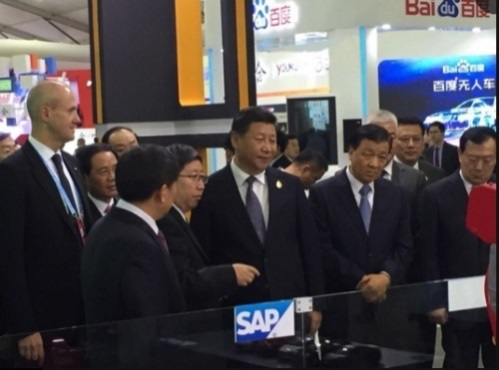
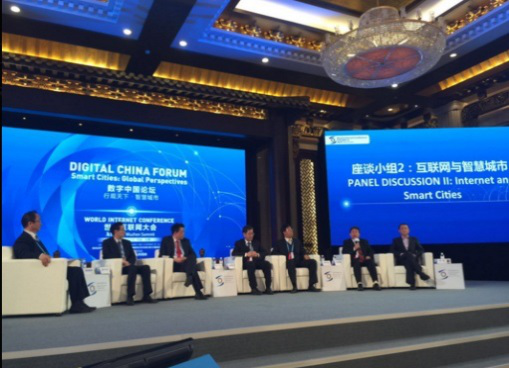
On June 14, 2016, German Chancellor Angela Merkel visited the demonstration system during a visit to Shenyang. The Global Product and Innovation President of SAP introduced the first Industry 4.0 demonstration line to Chancellor Merkel. Chancellor Merkel was greatly impressed by the demonstration.
Figure 9-3 German Chancellor Angela Merkel visits the platform in Shenyang
